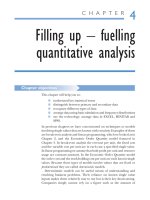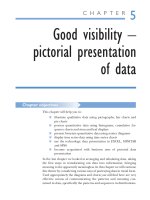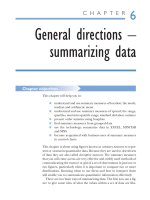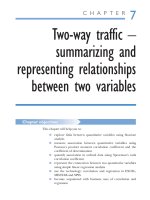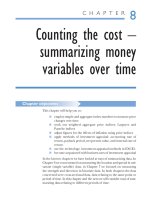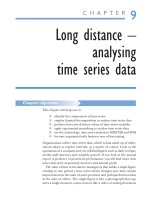Research methods for business 5th ch2
Bạn đang xem bản rút gọn của tài liệu. Xem và tải ngay bản đầy đủ của tài liệu tại đây (393.77 KB, 30 trang )
Slide 2.1
Chapter 2
Formulating and clarifying the research
topic
Saunders, Lewis and Thornhill, Research Methods for Business Students, 5th Edition, © Mark Saunders, Philip Lewis and Adrian Thornhill 2009
Slide 2.2
Formulating and clarifying your
research topic
The important steps
• Identifying the attributes of a good research
topic
• Generating ideas that help you select a suitable
topic
• Turning ideas into clear research questions and
objectives
• Writing your research proposal
Saunders, Lewis and Thornhill, Research Methods for Business Students, 5th Edition, © Mark Saunders, Philip Lewis and Adrian Thornhill 2009
Slide 2.3
Attributes of a good research topic (1)
Capability: is it feasible?
• Are you fascinated by the topic?
• Do you have the necessary research skills?
• Can you complete the project in the time available?
• Will the research still be current when you finish?
• Do you have sufficient financial and other
resources?
• Will you be able to gain access to data?
Saunders, Lewis and Thornhill, Research Methods for Business Students, 5th Edition, © Mark Saunders, Philip Lewis and Adrian Thornhill 2009
Slide 2.4
Attributes of a good research topic (2)
Appropriateness:
is it worthwhile?
• Will the examining institute's standards be met?
• Does the the topic contain issues with clear links to
theory?
• Are the research questions and objectives clearly
stated?
• Will the proposed research provide fresh insights
into the topic?
• Are the findings likely to be symmetrical?
• Does the research topic match your career goals?
Saunders, Lewis and Thornhill, Research Methods for Business Students, 5th Edition, © Mark Saunders, Philip Lewis and Adrian Thornhill 2009
Slide 2.5
Attributes of a good research topic (3)
And - (if relevant)
Does the topic relate clearly to an idea
you were given possibly by your organisation ?
Saunders, Lewis and Thornhill, Research Methods for Business Students, 5th Edition, © Mark Saunders, Philip Lewis and Adrian Thornhill 2009
Slide 2.6
Generating research ideas
Useful Techniques
Rational thinking Creative thinking
Searching the literature Scanning the media
Brainstorming
Relevance Trees
Exploring past projects Discussion
Keeping an ideas notebook
Saunders, Lewis and Thornhill, Research Methods for Business Students, 5th Edition, © Mark Saunders, Philip Lewis and Adrian Thornhill 2009
Slide 2.7
Refining research ideas
• Using the Delphi Technique
• Conducting a preliminary study
• Continually testing out your ideas
• Integrating ideas
• Refining topics given to you by your organisation
Saunders, Lewis and Thornhill, Research Methods for Business Students, 5th Edition, © Mark Saunders, Philip Lewis and Adrian Thornhill 2009
Slide 2.8
Saunders, Lewis and Thornhill, Research Methods for Business Students, 5th Edition, © Mark Saunders, Philip Lewis and Adrian Thornhill 2009
Slide 2.9
Saunders, Lewis and Thornhill, Research Methods for Business Students, 5th Edition, © Mark Saunders, Philip Lewis and Adrian Thornhill 2009
Slide 2.10
Writing research questions
Write research questions that are
• Consistent with expected standards
• Able to produce clear conclusions
• At the right level ( not too difficult )
• Not too descriptive
• Use the ‘Goldilocks Test’
Clough and Nutbrown (2002)
Saunders, Lewis and Thornhill, Research Methods for Business Students, 5th Edition, © Mark Saunders, Philip Lewis and Adrian Thornhill 2009
Slide 2.11
Saunders, Lewis and Thornhill, Research Methods for Business Students, 5th Edition, © Mark Saunders, Philip Lewis and Adrian Thornhill 2009
Slide 2.12
Turning ideas into research projects (1)
Examples of research ideas
and their derived focus questions
Table 2.2 Examples of research ideas and their derived focus research
questions
Saunders, Lewis and Thornhill, Research Methods for Business Students, 5th Edition, © Mark Saunders, Philip Lewis and Adrian Thornhill 2009
Slide 2.13
Turning ideas into research projects (2)
Useful techniques
• Start with a general focus question
• Use the ‘Russian Doll’ principle to reach the
essence of the question
• Discuss areas of interest with your tutor
Saunders, Lewis and Thornhill, Research Methods for Business Students, 5th Edition, © Mark Saunders, Philip Lewis and Adrian Thornhill 2009
Slide 2.14
Turning ideas into research projects (3)
Writing clear research objectives
• Check your examining body’s preferences for
stated objectives
• Use a general focus question to achieve
precise objectives
Saunders et al. (2009)
Saunders, Lewis and Thornhill, Research Methods for Business Students, 5th Edition, © Mark Saunders, Philip Lewis and Adrian Thornhill 2009
Slide 2.15
Turning ideas into research projects (4)
Include SMART Personal objectives
S pecific
M easurable
A chievable
R ealistic
T imely
Saunders, Lewis and Thornhill, Research Methods for Business Students, 5th Edition, © Mark Saunders, Philip Lewis and Adrian Thornhill 2009
Slide 2.16
Saunders, Lewis and Thornhill, Research Methods for Business Students, 5th Edition, © Mark Saunders, Philip Lewis and Adrian Thornhill 2009
Slide 2.17
Saunders, Lewis and Thornhill, Research Methods for Business Students, 5th Edition, © Mark Saunders, Philip Lewis and Adrian Thornhill 2009
Slide 2.18
Saunders, Lewis and Thornhill, Research Methods for Business Students, 5th Edition, © Mark Saunders, Philip Lewis and Adrian Thornhill 2009
Slide 2.19
Saunders, Lewis and Thornhill, Research Methods for Business Students, 5th Edition, © Mark Saunders, Philip Lewis and Adrian Thornhill 2009
Slide 2.20
Saunders, Lewis and Thornhill, Research Methods for Business Students, 5th Edition, © Mark Saunders, Philip Lewis and Adrian Thornhill 2009
Slide 2.21
Saunders, Lewis and Thornhill, Research Methods for Business Students, 5th Edition, © Mark Saunders, Philip Lewis and Adrian Thornhill 2009
Slide 2.22
The importance of theory
• Asking for opinions and gathering facts – 'what'
questions (descriptive research)
• Using questions that go beyond description and
require analysis – 'why' questions
Phillips and Pugh (2005)
In order to:
Explain phenomena
relationships
Predict outcomes
Analyse
Compare and generalise
Saunders, Lewis and Thornhill, Research Methods for Business Students, 5th Edition, © Mark Saunders, Philip Lewis and Adrian Thornhill 2009
Slide 2.23
Threefold typology of theories
Grand, middle range and substantive theories
Creswell (2002)
Figure 2.1 Grand, middle-range and substantive theories
Saunders, Lewis and Thornhill, Research Methods for Business Students, 5th Edition, © Mark Saunders, Philip Lewis and Adrian Thornhill 2009
Slide 2.24
Writing your research proposal
Purposes of the research proposal
• To organise your ideas
• To convince your audience
• To contract with your client (your tutor)
• To meet ethical requirements
Saunders, Lewis and Thornhill, Research Methods for Business Students, 5th Edition, © Mark Saunders, Philip Lewis and Adrian Thornhill 2009
Slide 2.25
Saunders, Lewis and Thornhill, Research Methods for Business Students, 5th Edition, © Mark Saunders, Philip Lewis and Adrian Thornhill 2009



